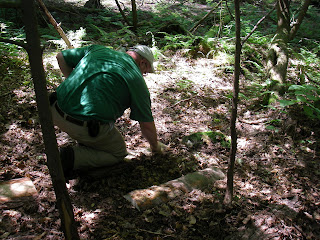 |
| Blue-spotted x Jefferson hybrid Salamander |
Blue-spotted x Jefferson hybrid Salamander is protected and listed in Connecticut as an endangered species. This species inhabits White Memorial and due to it's protected status we monitor this population using a couple of methods. We document breeding in vernal pools and other water bodies that this species uses for laying their eggs. Cover boards are placed in or near appropriate habitats. Finally, we record all other observations because every observation of this species tell us more.
I wanted to share with you some analysis from the cover board monitoring program in this post. Caitlin MacGinitie and her mother Mary Gendron checked the cover boards each month between April to September from 2007 - 2010. We have a total of 8 cover board plots located around the Museum, Duck Pond, and Windmill Hill vicinity. Caitlin and Mary checked the cover board plots a total of 152 visits over 4 years. Thier dedication was remarkable and we thank them for it. I also want to acknowledge Faye Curran for her help with collating the data so that we could conduct this initial analysis.
 |
The average number of salamanders observed per cover
board plot increased each month from April to September. |
I computed the average number of salamanders observed per cover board plot for each month through the 4 years. An interesting pattern emerged from the data. The number of salamanders increased as the summer season progressed. When we check the boards in the later part of summer, most of the salamanders are young of the year animals emerging from the breeding habitat. This indicates that cover boards might be a useful tool for monitoring Blue-spotted x Jefferson hybrid Salamanders productivity of breeding habitats. This will give us the ability to monitor how many juveniles are added to the population each year. Currently, our encounter rate is quite low. We need to increase our survey effort so that we can measure the proportion of animals that survive each winter to reproduce the following spring.
Caitlin and Mary have done their part and decided to retire when it came time for Caitlin to pursue a Bachelor of Science at Vassar College. Now we need your help to carry the torch. If you are interested in helping with this project please contact James Fischer, WMCC Research Director.

























